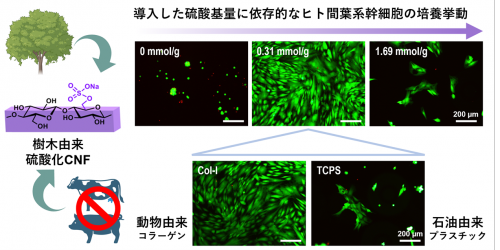Professor Takuya Kitaoka and his research group have successfully developed xeno-free cell culture scaffolds for human stem cells using plant-derived nanofibers, completely free of animal-derived components.
Toward the development of novel biomaterials for regenerative medicine with reduced risks of immune rejection and infection
Points
- The realization of regenerative medicine critically depends on the establishment of stem cell culture systems that completely eliminate the use of animal-derived components.
- By introducing sulfate groups into cellulose nanofiber* (CNF) derived from wood, the research team successfully achieved sulfate group-dependent regulation of human stem cell adhesion and proliferation, as well as stabilization of adhesion factors and culture media.
- This approach holds promise as a novel medical modality for the ex vivo controlled culture of human stem cells, with potential therapeutic benefits.
Abstract
Regenerative medicine is a therapeutic approach aimed at repairing or restoring tissues and organs whose functions have been impaired due to disease or injury. To realize this technology, it is essential to efficiently and appropriately culture human cells outside the body. Traditionally, this has required the use of culture substrates derived from non-human animal sources, such as collagen and other biological components. However, due to concerns regarding immune rejection and the risk of infectious diseases, there has been a growing demand for the development of cell culture substrates that are completely free of animal-derived components--commonly referred to as xeno-free materials.
In this study, we successfully established a xeno-free culture system for primary human mesenchymal stem cell** (MSC, derived from bone marrow) by introducing sulfate groups--a type of biofunctional moiety--specifically onto the crystalline surfaces of cellulose nanofiber (CNF), a structural polysaccharide derived from wood. This achievement was realized without the use of any animal-derived components, and the resulting culture performance was comparable to that of conventional animal-derived collagen-based substrates.
A collaborative research team comprising Ms. Ritomo Kai (Master's degree completed in FY2024) from the Graduate School of Bioresource and Bioenvironmental Sciences, Assistant Professor Mayumi Hatakeyama and Professor Takuya Kitaoka from the Faculty of Agriculture, Kyushu University, and Dr. Shinichiro Iwamoto from Yokogawa Electric Corporation focused on two nanostructural features common to both wood and human cells: the nanofibrillar morphology and the regular polysaccharide interfacial structure. By introducing sulfate groups onto the crystalline surfaces of cellulose nanofibers (CNFs) while preserving their native crystal structure, they discovered that CNFs exhibit excellent cell adhesion and proliferation properties. Furthermore, they found that stem cell culture behavior is highly sensitive and strongly dependent on the amount of sulfate groups introduced, and that these modified CNFs contribute to the stabilization of proteins essential for initial stem cell adhesion and subsequent proliferation.
This discovery is expected to contribute not only to direct regenerative medicine applications using human stem cells, but also to the development of technologies for generating functional cells with tissue- and organ-like properties ex vivo, as well as to foundational drug discovery platforms that leverage such technologies.
This research was published online on Friday, July 4, 2025, in the Elsevier journal Carbohydrate Polymer Technologies and Applications.
Researcher's Comment

Forestry resources provide numerous benefits to humanity. Among them, cellulose nanofibers (CNFs), polysaccharides derived from wood, represent the world's largest carbon fixation material. In addition to contributing to global environmental conservation and the sustainable use of natural resources, CNFs have now been shown to support human health and longevity. These findings open new avenues for biomedical research utilizing naturally structured polysaccharides, which cannot be artificially synthesized.
(Takuya Kitaoka)
Glossary
* Cellulose Nanofiber (CNF)
A natural nanomaterial obtained by refining cellulose--the primary structural component of plants such as trees and grasses--down to the nanometer scale (1 nanometer = one-billionth of a meter).
** Mesenchymal Stem Cell (MSC)
Stem cells found in adult tissues that have the ability to differentiate into various cell types, including bone, cartilage, adipose, and muscle cells.
Publication Information
Journal: Carbohydrate Polymer Technologies and Applications
Title: Adhesion and proliferation behavior of primary human mesenchymal stem cells on sulfated cellulose nanofiber scaffolds with different sulfate contents
Authors: Ritomo Kai, Mayumi Hatakeyama, Shinichiro Iwamoto, Takuya Kitaoka
DOI:10.1016/j.carpta.2025.100930
Contact Information












 Contact
Contact
 Access Map
Access Map

